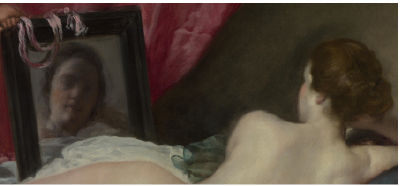|
Ray diagrams are used to trace the path of light rays through an optical system. The angle of incidence and angle of reflection are measured with respect to the normal to the reflecting surface. The law of reflection states that the angle of incidence equals the angle of reflection. When light is reflected from a flat mirror, an image forms behind the mirror at the point from which the reflected rays appear to diverge. The image distance for a flat mirror equals the object distance, which is the distance between the object and the reflecting surface. 
|
|
incident ray, reflected ray, normal, law of reflection, angle of incidence, angle of reflection, image
|
|
|
|
Review problems and questions |
|
- Does the law of reflection apply to specular reflection, diffuse reflection, or both types of reflection?


|
The law of reflection associates a single reflected ray with a single incident ray. On a macroscopic level, this applies only to specular reflection. A diffuse surface, in contrast, scatters incident rays at random angles. (The law of reflection can still hold for a region that is small enough to be considered smooth.)
On a microscopic level, however, much of the process of diffuse reflection occurs through many little reflections off of surfaces within a material. When these little surfaces are oriented in many different directions, such as for ice crystals, the incident light can be reflected back into many different directions. Each one of these little surfaces by itself, though, obeys the law of reflection, where the angle of reflection equals the angle of incidence. 
|

- In the Diego Velasquez work Venus and Cupid, the artist depicted the subject looking into a mirror. Is she looking at herself in the mirror? Why or why not?


|
The subject is looking at the viewer of the painting. Because the viewer sees the subject’s face in the mirror, the subject also sees the viewer. The mirror would have to be tilted toward her for her to see her own reflection. 
|
- Some interior designers place a large, flat mirror on one wall of a room to make the room feel bigger. Explain their argument using the physics of mirrors and image formation.


|
The wall mirror reflects the light from various objects in the room, forming images of each object behind the mirror—with each image located a distance behind the mirror equal to the object’s distance in front of the mirror. The room seems bigger because we can see objects and images together occupying a space twice as large as the room itself. 
|
- A laser beam hits a mirror at an angle of incidence of 65°.
- What is the angle of reflection of the laser beam?
The laser then hits a mirror perpendicular to the first. - What is the angle of incidence of the laser to this mirror?
- What is the angle of reflection from the second mirror?


|
Answer: - 65°
- 25°
- 25°
Solution: - The angle of reflection θr = 65°. The law of reflection states that the angle of incidence is equal to the angle of reflection.
- The angle of incidence θi = 25°. Because the second mirror is perpendicular to the first, the angle at which the ray hits this second mirror is complementary to the angle of reflection from the first mirror: so
- The angle of reflection θr = 25°. The law of reflection states that the angle of incidence is equal to the angle of reflection.

- A young man is standing 87.3 cm in front of a flat mirror. He sees the image of a light bulb at an angle of reflection of 57.9°. The light bulb is physically located 175 cm in front of the mirror. What is the image distance for the image of the bulb in the mirror (i.e., the distance behind the mirror at which the image of the bulb appears)?


|
Answer: The image distance is 175 cm. For a flat mirror, the image appears to be at a distance behind the mirror equal to the object’s distance in front of it. None of the other information in the question is relevant. 
|
- In drawing a ray diagram, a student drew an incident ray that passed along a normal to the surface of the mirror. What is the value of the angle of reflection?


|
Answer: The angle of reflection is 0°. The angle of incidence is the angle between the incident light ray and the normal to the surface, which, in this case, is 0° because the two are coincident. The angle of reflection equals the angle of incidence by the law of reflection, so the angle of reflection is also 0°. 
|
Take a Quiz |
|

